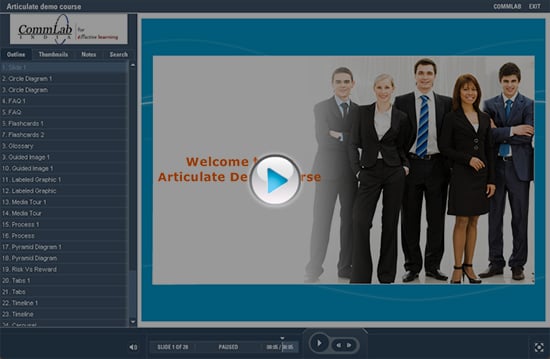Can We Create Highly Interactive Courses Using Rapid Authoring tools

Rapid eLearning is used to create interactive courses at low cost and in a short time frame. This does not mean that it is not possible to develop courses of the highest quality using the rapid authoring tools. Quality is something that need not be compromised at all in the process. One can produce interesting eLearning courses without skipping essential instructional designing steps within the limitations of rapid authoring tools.
Most of the time, bad eLearning is due to lack of creativity and effort by the developer and quite frankly, rapid authoring tools are really not the culprit. If you come across bad eLearning courses, it could be because the developers of the courses have either limited knowledge about the potential of the tools or lack of skills and creativity to exploit the features provided by them. Even a simple PowerPoint tool can be effectively used to produce an engaging and interactive eLearning course. All you need is a deep knowledge and expertise in using that tool.
Let’s look at the type of interactions that can be created with 3 Rapid authoring tools, Lectora, Articulate and Captivate.
Lectora:
Lectora allows you to create graphically rich interface and to develop HTML-based courses very quickly. The following interactions can be created with Lectora.
Slide Show:
The learners need to click the right and left arrows in order to navigate through the slides. The slides may contain only text, a combination of text and images or only images.
Roll Over:
Used for random navigation, it provides layered information and highlights required parts of a visual. Photos, illustrations and screen shots can be used as “Roll Over”.
Click on Numbers:
They present layered information and need to be accessed sequentially.
Articulate:
It is used to convert power point presentations directly to create an eLearning course. Let us see what types of interactivities can be created in articulate.
Hotspots:
Hotspots are interactive shapes that zoom and highlight the parts of a product or a visual to provide layered information.
Media Tour:
A media tour is used to represent an idea or concept through animation which details out the ideas of the concept.
Captivate:
Captivate in useful in creating application training and software tutorial easily and quickly. Let’s see the interactivities that can be developed using Captivate.
Watch Try Do Simulations:
Watch, Try and DO is an effective approach to train learners on how to use a particular software or product. It provides an opportunity for the learner to learn, practice and execute an action.
Click on Images:
When the user clicks on an image the related information will be displayed in a pop up box. It allows the user to explore the information and keeps him engaged.
Scenario/case study:
Real pictures of individuals are used in scenarios with background which depicts the environment in which the scenarios are taking place. This will help learner connect with the situation easily and also makes the screen visually rich.
Therefore, boring, ineffective page turning eLearning courses are produced NOT because these tools are incapable of producing anything better. On the contrary, it is because the people who use the tools are not adept in using and harnessing the potential of these tools to their fullest extent.
Here is the demo of a course developed in Articulate which shows various interactivities. Click on the below image to access the complete demo.




![Microlearning & AI: A Complete Guide [Design Tips + Best AI Tools Included]](https://blog.commlabindia.com/hubfs/blogs/ai-tools-create-microlearning-courses.jpg)

